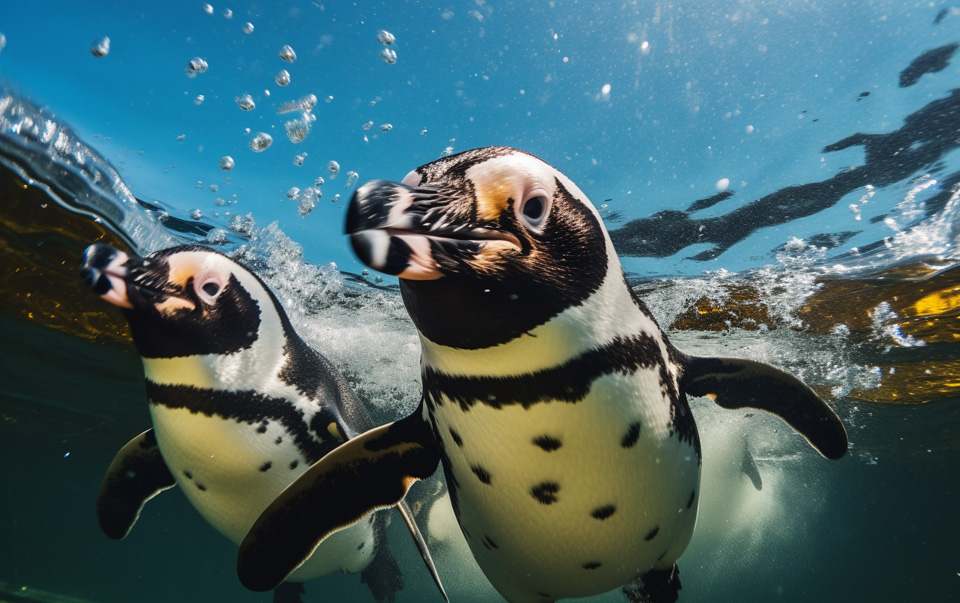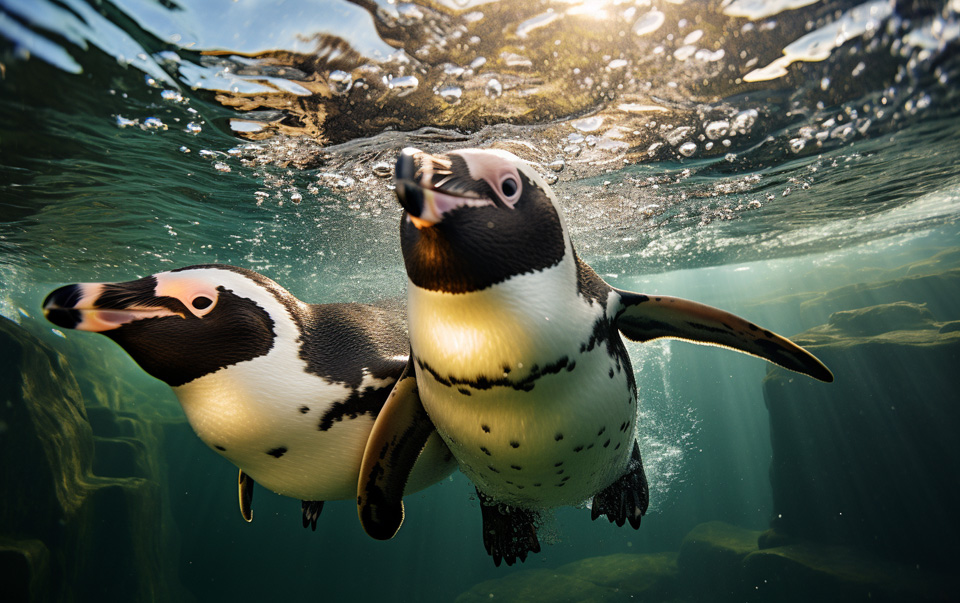Penguins are fascinating creatures that have captured our imagination with their unique abilities. One of their most impressive skills is their swimming prowess, as they are well-adapted to life in the water. We often wonder how fast penguins can swim and what sets them apart from other aquatic animals.
Penguins swim at different speeds depending on the species. Most penguins swim underwater at around four to seven miles per hour (mph), with the fastest penguin, the gentoo, able to reach top speeds of 22 mph.
In this article, we will delve into the speed of penguins in water and explore their remarkable swimming abilities.
Key Takeaways:
- Penguins are known for their impressive swimming abilities.
- Most penguins swim underwater at speeds of four to seven miles per hour (mph).
- The gentoo penguin is the fastest, reaching top speeds of 22 mph.
- Penguins’ wings have evolved into flippers that help them navigate through water with ease.
- Their black and white coloration aids in camouflage and predator avoidance.
Different Penguin Species and their Swimming Speeds
There are 17–20 species of penguins alive today, all of which live in the southern half of the globe. The most northerly penguins are Galapagos penguins, which occasionally venture north of the equator.
Each penguin species has its own swimming speed, with the gentoo penguin being the fastest, reaching speeds of 22 mph.
Emperor penguins can swim up to 10.8 kph (6.7 mph), Adélie penguins can reach burst speeds of 30 to 40 kph (18.6 to 24.8 mph), and king penguins have a maximum swim speed of 12 kph (7.6 mph).
Little penguins swim at a slower speed of about 2.5 kph (1.6 mph). Different species of penguins have adapted to their unique habitats and prey, which influences their swimming capabilities.
Diving and Feeding Habits of Penguins

Penguins are fascinating creatures that spend a significant amount of time in the sea, only making their way ashore for breeding and molting. One of the remarkable abilities they possess is their diving prowess, allowing them to hunt for prey in the depths of the ocean.
Among the different species of penguins, Adélie penguins have been observed staying underwater for nearly six minutes, venturing to depths of up to 170 meters (558 feet) in search of their preferred prey.
King penguins, on the other hand, can dive for up to eight minutes and reach impressive depths of 343 meters (1,125 feet).
“Adélie penguins have been recorded staying underwater for nearly six minutes and diving to depths of up to 170 meters (558 feet). King penguins can dive for up to eight minutes, reaching depths of 343 meters (1,125 feet).” – Researchers
However, it is the emperor penguin that truly stands out in terms of diving abilities. Known for hunting midwater squids and fishes, emperor penguins can dive to astounding depths of 565 meters (1,854 feet) and remain submerged for up to 27.6 minutes, showcasing their incredible adaptation to the marine environment.
Penguins primarily hunt for prey in pelagic waters, where they can find an abundance of fish, squid, and krill. However, some species, such as the gentoo, yellow-eyed, and emperor penguins, have also been observed diving and feeding at the benthic level, expanding their hunting capabilities.
Key Points:
- Penguins spend a significant amount of time at sea, only coming ashore for breeding and molting.
- Adélie penguins can stay underwater for up to six minutes and dive to depths of up to 170 meters (558 feet).
- King penguins can dive for up to eight minutes and reach depths of 343 meters (1,125 feet).
- The emperor penguin can dive to depths of 565 meters (1,854 feet) and stay submerged for up to 27.6 minutes.
- Penguins primarily hunt prey in pelagic waters, but some species also dive and feed at the benthic level.
Adaptations for Efficient Swimming
Penguins have evolved several adaptations that enable them to be efficient and agile swimmers in their aquatic habitat. These adaptations contribute to their remarkable swimming abilities and allow them to navigate through the water with ease.
“Penguins have wings that have transformed into paddle-like flippers resembling the wing movements of flying birds. These specialized flippers, along with their well-developed wing and breast muscles, propel them through the dense water.”
When swimming, penguins hunch their heads into their shoulders, maintaining a streamlined shape that reduces drag and enhances their hydrodynamics. By keeping their feet pressed close to their bodies against the tail, penguins can effectively steer themselves in their underwater journey.
- The wing structure of penguins, featuring paddle-like flippers, allows for efficient propulsion through water.
- Penguins hunch their heads into their shoulders, maintaining a streamlined shape and reducing drag.
- By pressing their feet against their bodies, penguins improve their steering capabilities.
- Penguins possess dense bones that help them overcome buoyancy, enabling better control and maneuverability in the water.
- Furthermore, penguins have glands located under their eyes that assist in removing excess salt from their bodies, aiding in overall swimming performance.
These remarkable adaptations of the penguins’ wing structure, streamlined bodies, and specialized physiological features allow penguins to excel as graceful and efficient swimmers. Through these adaptations, penguins have thrived in their aquatic environment, capturing the curiosity and awe of researchers and nature enthusiasts alike.
Conclusion
Penguins are truly remarkable creatures when it comes to their swimming capabilities. With each species showcasing its own unique set of skills, these birds have adapted in extraordinary ways to conquer the aquatic environment.
From the lightning-fast gentoo penguin, reaching speeds of up to 22 mph, to the deep-diving emperor penguin, capable of exploring depths of 565 meters (1,854 feet), their swimming abilities are nothing short of impressive.
What sets penguins apart is not just their speed, but also their efficient and agile movements in the water. Their streamlined bodies and specialized wing structures, designed like flippers, allow them to glide effortlessly through the waves.
Penguins have truly mastered the art of hydrodynamics, using their muscular wings to traverse the water with precision and grace. These adaptations help them navigate their oceanic habitat with ease, enabling them to hunt for their preferred diet of fish, squid, crabs, and krill.
The fascinating world of penguins and their unparalleled swimming skills continues to captivate researchers and nature enthusiasts around the globe. Whether it’s studying their diving depths or marveling at their sleek maneuvers, we are constantly amazed by the incredible adaptations that have evolved over millions of years.
Penguins truly embody the wonders of nature, showcasing a perfect balance of power, agility, and elegance as they navigate the depths of the ocean.
FAQ
How fast can penguins swim?
Penguins swim at different speeds depending on the species. Most penguins swim underwater at around four to seven miles per hour (mph), with the fastest penguin, the gentoo, able to reach top speeds of 22 mph.
What are the swimming speeds of different penguin species?
Each penguin species has its own swimming speed. The gentoo penguin is the fastest, reaching speeds of 22 mph. Emperor penguins can swim up to 10.8 kph (6.7 mph), Adélie penguins can reach burst speeds of 30 to 40 kph (18.6 to 24.8 mph), and king penguins have a maximum swim speed of 12 kph (7.6 mph). Little penguins swim at a slower speed of about 2.5 kph (1.6 mph).
What are the diving and feeding habits of penguins?
Penguins have the ability to dive to catch prey. Different species dive to varying depths and stay submerged for different periods. Adélie penguins have been recorded staying underwater for nearly six minutes and diving to depths of up to 170 meters (558 feet). King penguins can dive for up to eight minutes, reaching depths of 343 meters (1,125 feet). Emperor penguins, known for hunting midwater squids and fishes, can dive to depths of 565 meters (1,854 feet) and stay submerged for up to 27.6 minutes.
What adaptations do penguins have for efficient swimming?
Penguins have several adaptations that make them efficient swimmers. Their wings have evolved into paddle-like flippers, their wing and breast muscles are well-developed, and they hunch their heads into their shoulders to maintain a streamlined shape. Penguins also keep their feet pressed close to their bodies against the tail for steering, have dense bones to overcome buoyancy, and possess glands under their eyes that aid in ridding their bodies of excess salt.
What are the swimming abilities of penguins?
Penguins are incredible swimmers, with different species showcasing various swimming speeds and diving abilities. From the gentoo penguin, known for its top speed of 22 mph, to the emperor penguin, capable of diving to depths of 565 meters (1,854 feet), these birds have adapted to their aquatic environment in remarkable ways.


